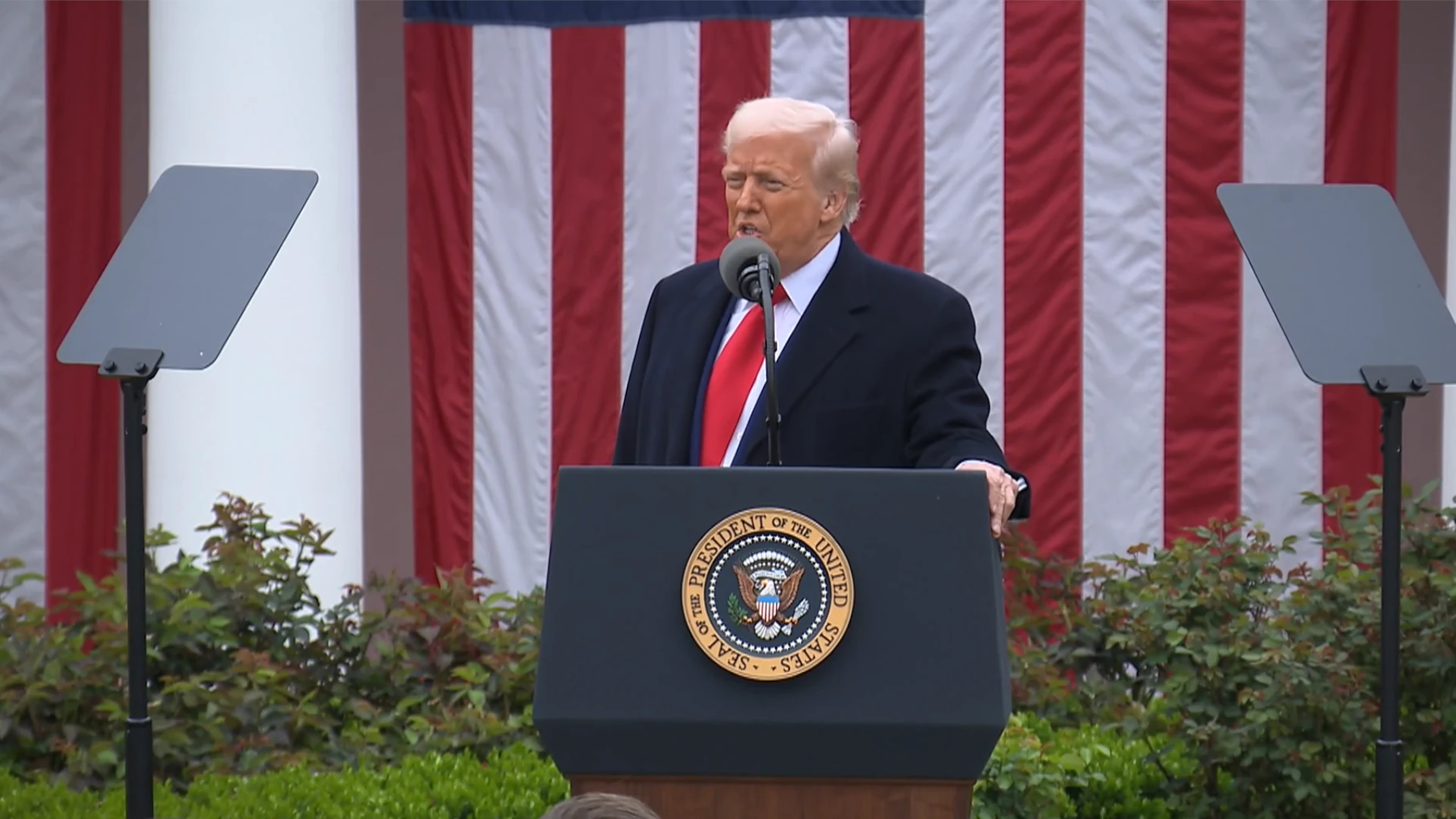President Donald Trump is expected to unveil a new round of tariffs on imported semiconductor chips this week—marking a bold escalation in his long-standing push to decouple the U.S. tech supply chain from East Asian manufacturing hubs. The move targets high-performance chips critical to everything from smartphones and gaming consoles to electric vehicles and AI-powered servers.
What Tariffs Mean for the Tech Industry
A Strategic Shift in U.S. Tech Trade Policy
Trump announced over the weekend that new tariffs will be imposed on semiconductor imports, emphasizing that full details will be shared “in the near future.” Sources close to the matter say the tariffs could begin at 25% and scale upward, in line with past Section 301 and Section 232 tariffs used during his previous administration. These tools are now being wielded again, this time under national security claims to address U.S. dependence on chipmakers in Taiwan, South Korea, Malaysia, Japan, and especially China.

This policy comes on the heels of an order for the Commerce Department to initiate a Section 232 investigation into semiconductor imports. That signals a long-term shift toward reshoring or near-shoring chip production—an area where the U.S. has fallen behind, producing only about 10-12% of global chips as of 2024.
Who Gets Hit — And Who Might Dodge the Tariff
While details are still emerging, officials have confirmed that consumer electronics like smartphones and computers may receive temporary exemptions. Companies like Apple and Nvidia have been granted short-term reprieves to shield iPhones and other key products from price shocks. However, those exemptions are described as “temporary” and subject to review.
The move is likely to affect a wide range of industries:
- Consumer tech manufacturers who rely on foreign chips for phones, tablets, and laptops
- Automotive companies increasingly dependent on advanced driver-assist and EV chips
- AI and data center firms like Meta, Google, and Amazon, which need large volumes of GPUs and NPUs
- Defense contractors, who rely on trusted supply chains for mission-critical components
Even U.S.-based tech giants who design their own chips—like Apple (with its M-series silicon) and Tesla (for its in-house AI chips)—still depend on fabrication plants in Asia, particularly Taiwan’s TSMC.
Industry Reaction and Investor Jitters
The tech sector is bracing for turbulence. Many industry leaders fear price hikes, delayed product launches, and reshuffling of supply lines. Investors have also expressed concern, with some calling the lack of long-term clarity a deterrent for domestic investment. The semiconductor sector is notoriously globalized, and decoupling could mean higher costs and slower innovation if not executed with precision.
There’s also a broader geopolitical angle. Taiwan produces over 60% of the world’s semiconductors and more than 90% of the most advanced ones. Any move that disrupts this balance—whether through tariffs or military tensions—has ripple effects on the global economy.
A Broader Economic Gamble
Critics argue that Trump’s tariff-heavy approach could backfire by triggering retaliatory measures from trade partners or pushing inflation higher in sectors that rely on cheap tech. Supporters counter that aggressive action is needed to build up America’s chip independence—especially after the COVID-era shortages and China’s recent push to corner the market on critical minerals and components.
At the center of this policy is a simple question: Should national security and industrial policy take precedence over short-term market efficiency? The Trump camp seems to believe so—and this week’s expected announcement will be a major step in testing that belief.
Expect a detailed breakdown of which chips and manufacturers will be affected in the coming days, as industry analysts, tech giants, and international trade partners await the final tariff framework.
Key Takeaways
- Trump plans to announce specific tariff rates on semiconductor chips within the next week while indicating some flexibility on product exemptions.
- The semiconductor tariffs represent a continuation of aggressive trade policies targeting technology sectors with strategic importance.
- Tech companies and consumers may face higher costs and market disruptions as the industry adapts to new trade barriers.
Background on Trump’s Trade Policies
President Trump has pursued aggressive trade policies throughout his time in office, particularly focusing on reducing trade deficits and protecting American industries. His administration has implemented various tariffs targeting different countries and sectors.
Previous Tariffs Under Trump Administration
Trump’s administration has consistently used tariffs as a key economic tool. In earlier terms, he imposed 25 percent tariffs on imports from Canada and Mexico, though he limited Canadian energy tariffs to 10 percent.
China has been a primary target of Trump’s trade policies. The administration previously implemented significant tariffs on Chinese goods, arguing they were necessary to balance trade relationships and protect American intellectual property.
These measures were part of Trump’s broader “America First” economic strategy. The administration claimed these policies would revitalize American manufacturing and create jobs in key industrial sectors.
Many businesses had to restructure their supply chains in response to these tariffs. Some companies moved production out of China to other countries, while others absorbed higher costs or passed them to consumers.
Impact of Trade Measures on the Global Economy
Trump’s tariff policies have created significant ripples throughout the global economy. Economists have warned that extremely high tariffs would effectively halt trade between major economies, with one expert noting that a 145% total tariff on Chinese imports would stop most trade between the U.S. and China.
Many businesses have reported “irreversible damage” from these trade policies. Supply chains built over decades have been disrupted, forcing companies to find alternative suppliers or manufacturing locations.
Global markets have responded with volatility to tariff announcements. Stock prices in affected industries often drop sharply following new tariff declarations, reflecting investor concerns about reduced profits and economic slowdown.
Trade partners have typically responded with retaliatory tariffs on American goods. This has created challenges for U.S. exporters, particularly in agricultural sectors, who have lost access to important international markets.
Details of the Proposed Chips Tariffs
President Trump’s planned tariffs will target semiconductor products from China with specific rates and timelines. The announcement has created significant market uncertainty about which products will be affected and how companies should prepare.
Affected Products and Sectors
The upcoming tariffs will primarily affect computer chips inside smartphones and other technologies. According to recent statements, semiconductors manufactured in China are the main target, though the full list of products remains unclear.
Initial reports suggested potential exemptions for consumer electronics like iPhones, but Trump has since indicated no exemption for iPhones and other Chinese-made electronics.
Tech companies that rely on Chinese-manufactured chips face significant supply chain disruptions. This includes:
- Smartphone manufacturers
- Computer and laptop producers
- Automotive electronics suppliers
- Consumer electronics companies
Tariff Rates and Implementation Timeline
President Trump plans to introduce the new semiconductor tariffs within the coming week. An official update on the administration’s approach is expected Monday, April 14, 2025.
The baseline tariff appears set at 10% for most imports, while Chinese goods could face substantially higher rates. China has already announced it will increase its retaliatory tariffs to 125% on U.S. goods, up from the previously planned 84%.
Trump has signaled that some exclusions may be granted, but emphasized these would be temporary rather than permanent exemptions. The implementation is expected to begin immediately after the official announcement.
Potential Reactions from the Tech Industry
The tech sector is bracing for significant disruptions as Trump’s upcoming semiconductor tariffs could reshape supply chains and pricing structures. Industry leaders have already begun mobilizing responses through public statements and behind-the-scenes advocacy efforts.
Statements from Major Chip Manufacturers
Intel and AMD executives have expressed “deep concerns” about the proposed tariffs in recent press briefings. Intel CEO Pat Gelsinger warned that new tariffs could “undermine America’s semiconductor leadership” despite the company’s domestic manufacturing presence.
Taiwan Semiconductor Manufacturing Company (TSMC), which supplies chips to Apple and other major tech firms, released a statement highlighting how tariffs might disrupt global supply chains.
Qualcomm representatives emphasized the potential for price increases on consumer electronics if the tariffs take effect. Their analysis suggests smartphone costs could rise by 8-12%.
Smaller chip designers that rely on Asian manufacturing have been particularly vocal, with industry consortium surveys showing 76% expect negative impacts on their business models.
Lobbying Efforts and Legal Challenges
The Semiconductor Industry Association has doubled its lobbying budget, deploying representatives to meet with key administration officials. Their primary argument centers on how tariffs could counteract the CHIPS Act investments meant to strengthen domestic semiconductor production.
Tech companies have formed a coalition called “Digital Economy Forward” to challenge the tariffs. They’ve prepared legal briefs arguing the tariffs violate international trade agreements.
Apple has taken a unique approach by highlighting its commitment to U.S. manufacturing expansion, possibly explaining why iPhones might receive special flexibility in the tariff scheme.
Several companies are exploring legal challenges through the WTO and U.S. courts, with preliminary filings already drafted ahead of the official tariff announcement.
Implications for International Trade Relations
Trump’s anticipated chip tariff announcement has already sent ripples through global trade relationships. Major economies are preparing responses while trade negotiators evaluate how these tariffs might reshape future agreements.
Responses from Key Trading Partners
China has swiftly retaliated against President Trump’s expanding tariff policies by raising duties on U.S. imports to 125% from 84%. This escalation signals a deepening trade conflict between the world’s two largest economies.
European Union officials have expressed concern about the potential disruption to semiconductor supply chains. Several EU nations with significant technology sectors have indicated they may seek exemptions or negotiate alternative arrangements.
South Korea and Taiwan, both critical in the global chip production ecosystem, have initiated diplomatic channels to discuss potential impacts. These nations face particular vulnerability as major exporters of semiconductor technologies.
Japan’s trade ministry has scheduled emergency meetings with industry leaders to formulate a coordinated response to protect their semiconductor industry interests.
Influence on Future Trade Agreements
The semiconductor tariff decisions will likely reshape ongoing trade negotiations, particularly those involving technology sectors. Several pending agreements may now require significant revision to address new market realities.
The exemptions for smartphones, computers, and certain electronic devices suggest a strategic approach rather than blanket restrictions. This nuanced policy may provide negotiating leverage in future trade talks.
Trade experts note that Trump’s “reciprocal” tariff approach indicates a preference for bilateral agreements rather than multilateral frameworks. This shift could fundamentally alter how technology trade provisions are structured in coming years.
The uncertainty surrounding chip tariffs has already affected investment decisions, with some manufacturers delaying expansion plans until policy details become clearer. This hesitation may influence how urgently trade partners pursue new agreements.
Regional trade blocs are reassessing their semiconductor policies to reduce dependency on affected supply chains, potentially creating new alliances outside traditional trading patterns.
Frequently Asked Questions
The upcoming tariffs on semiconductor chips raise important questions about trade relations, industry impacts, and consumer prices. These tariffs represent a significant shift in U.S. trade policy toward technology imports.
What implications do the new chips tariffs have for international trade relations?
The new chips tariffs could strain relations with China and other manufacturing countries. President Trump’s announcement signals a continued aggressive stance on trade.
These tariffs may trigger retaliatory measures from affected nations, particularly China, which has already raised duties on U.S. goods to 125% in response to earlier tariffs.
International trade organizations might also become involved, potentially reviewing whether these tariffs comply with global trade agreements.
How might the Trump administration’s tariff policy affect the semiconductor industry?
The semiconductor industry faces significant adjustment challenges with these new tariffs. U.S. chip manufacturers may benefit from reduced foreign competition, potentially increasing their market share.
However, companies relying on imported components could see production costs rise. This might force industry players to reconsider their supply chains and manufacturing locations.
The policy appears to exempt certain electronics temporarily, but Trump has indicated these exclusions will be temporary, creating uncertainty for long-term industry planning.
What is the anticipated impact of the new chips tariffs on consumer electronics prices?
Consumer electronics prices are likely to increase as manufacturers pass tariff costs to customers. Phones, computers, and other devices containing semiconductors will become more expensive.
While some products like iPhones may receive temporary exemptions, Trump has signaled these protections won’t last forever. Consumers should prepare for gradual price increases.
The timing of these price hikes might vary by product category depending on existing inventory levels and how quickly manufacturers implement pricing changes.
What are the main objectives behind the newly proposed chips tariffs announcement?
The administration cites national security concerns as a primary motivation for the new tariffs. Trump has indicated these chips will face a national security probe, suggesting strategic concerns about supply chain vulnerabilities.
Economic protection for domestic manufacturers represents another key objective. The policy aims to encourage reshoring of semiconductor production to the United States.
These tariffs also serve as negotiating leverage in broader trade discussions with China and other manufacturing nations.
How could the new tariffs on chips influence the global supply chain and manufacturing sector?
Global supply chains face significant disruption as companies reassess sourcing strategies. Manufacturers may accelerate plans to diversify production beyond China to avoid tariffs.
Companies might invest in automation to offset higher labor costs when moving production to the U.S. or allied countries. This could create fewer but higher-skilled manufacturing jobs.
The semiconductor industry’s highly specialized production ecosystem means companies cannot quickly relocate facilities, creating short-term supply constraints.
Are there any potential retaliatory measures expected from the countries affected by the new tariffs on chips?
China has already demonstrated its willingness to retaliate by increasing tariffs on U.S. goods. Further escalation could target American industries dependent on Chinese markets.
Other affected countries might implement their own targeted tariffs on U.S. exports. These could strategically focus on politically sensitive industries in key electoral states.
Non-tariff barriers like regulatory hurdles, licensing requirements, or inspection delays might also increase for American businesses operating abroad.







